
* Corresponding author.
E-mail address: zr.firdaous@gmail.com (F. Zair)
© 2019 by the authors; licensee Growing Science, Canada.
doi: 10.5267/j.dsl.2018.7.001
Decision Science Letters 8 (2019) 175–192
Contents lists available at GrowingScience
Decision Science Letters
homepage: www.GrowingScience.com/dsl
Advanced supplier selection: A hybrid multi-agent negotiation protocol supporting supply
chain dyadic collaboration
Maryam Nejmaa, Firdaous Zairb*, Abdelghani Cherkaouia and Mohamed Fourkab
aEMISys Team, Engineering 3S Research Center, Mohammadia School of Engineering, Rabat, Morocco
bDepartment of Mechanical Engineering, Faculty of Sciences and Technics, University of Abdelmalek Essaadi, Tangier, Morocco
C H R O N I C L E A B S T R A C T
Article history:
Received March 12, 2018
Received in revised format:
July 7, 2018
Accepted July 7, 2018
Available online
July 7, 2018
This paper proposes a novel form of supplier selection involving the supply chain dyad as the
buyer and the suppliers as sellers. The main proposed contribution is a multi-attribute decision
hybrid protocol for supplier selection based on collaboration and negotiation, adapted to dyadic
collaboration in a supply chain context. Suppliers and the purchasing dyad can reach an
agreement on the details of the products simultaneously and exploit the preferences of the
customer dyadic partner to enlarge the criteria choices of the products. For this, the proposed
protocol combines a one-to-one bilateral dyadic collaboration protocol inside the purchasing
dyad along with a one-to-many multi-bilateral bargaining protocol between the purchasing dyad
and suppliers. Illustrative multi-agent simulation experiments were carried out to prove the
effectiveness of the proposed protocol. The protocol implementation shows better negotiation
results than the classic supplier selection process, along with expected higher customer partner
satisfaction and a more embedded dyadic relationship.
.2018 by the authors; licensee Growing Science, Canada©
Keywords:
Supplier selection
Multi-agent systems
Dyadic collaboration
Supply chain dyad
Hybrid negotiation protocol
Agent negotiation
1. Introduction
In the 21st century market, a high-performance supply chain management (SCM) is extremely
important in order to maintain competitiveness and excellence. The literature reports two main
problems that impact significantly on SCM: supplier selection, and collaboration inside the SC.
Collaboration describes how supply chain (SC) organisations work dynamically together and share
information to meet particular mutual objectives (Hernández et al., 2011). In the literature, dyadic
collaboration refers to a collaboration between two SC organisations. This is the most investigated type
of SC collaboration (Harland et al., 2005; Montoya-Torres & Ortiz-Vargas, 2014).
Supplier selection is a key decision for the buyer (Ghodsypour & O’Brien, 1998; Narasimhan, 1983).
Supplier selection is “finding the right suppliers who are able to provide the buyer with the right quality
products and/or services at the right price, at the right time and in the right quantities” (Boran et al.,
2009). When interests conflict during a supplier selection procedure, negotiation is necessary to attain

176
mutual agreement. The buyer defines the product characteristics according to its customer, and the
customer requirements indirectly lead the negotiations between the buyer and the suppliers. Therefore,
negotiations can be stiff and less profitable. However, is it practical to involve all of the buyer’s partners
in the negotiations? Obviously, no. A novel business relationships management strategy seems to be
required, especially given the actual market trends toward more product customisation. Consequently,
frequent interactions with the customer are compelling SCs used to design novel business strategies to
increase flexibility and adaptability, and to face the fierce worldwide competition. As Jahani et
al. (2015) stated: “unsatisfied customers, information overload and high uncertainty are the main
challenges that are faced by today’s supply chains”. In this sense, relationship-based strategies can be
promising. As Emmett and Crocker (2016) argue, rethinking businessmanagement according to a more
relationship-based approach is likely tobe transforming.
In this paper, a novel business strategy based on SC dyadic relationships has been argued as a promising
and affordable solution to support mass flexible customisation in future markets within the industry 4.0
context. The proposed strategy is about including the customer company in the procedure of supplier
negotiation. We argue that this might be more profitable than the classical method of supplier selection;
it reduces uncertainty in SC, and in particular, increases customer satisfaction, which is a key leverage
in SCs as previously mentioned. The present work verifies this claim by developing and testing a new
model of negotiation for the decision support systems of supplier selection involving suppliers and the
SC dyad of customer/buyer. The proposed model was developed using the multi-agent systems
paradigm, which is widely used for complex systems such as SCs.
Agents are commonly defined as intelligent computer systems capable of autonomous action in order
to achieve predefined objectives (Wooldridge & Jennings, 1995). Agents can work jointly as problem
solvers through competition or cooperation to resolve issues that are beyond their individual
capabilities (O’Hare et al., 1996). When studying the supplier selection process, agent-based
approaches are widely used (Chen et al., 2016; Ghadimi et al., 2018; Jahani et al., 2015; Pourabdollahi
et al. , 2017; Valluri & Croson, 2005; Yang & Kao, 2009). This paper makes the following main
contributions:
This paper is the first to take into account the customer company in the supplier selection process.
Consequently, it goes beyond internal collaboration inside the dyad, considering additional
dimensions such as the management of the dyad outside of the connection.
This paper combines negotiation and collaboration in the same protocol for supplier selection.
This paper employs agent technology to capture, through coordination, the dynamics of the buyer-
seller operations, which is a highly significant and challenging issue according to Ghadimi and
Heavey (2013). These dynamics are represented by:
(1) The collaboration dynamics of the buyer - seller operations inside the dyad
(2) The negotiation dynamics of buyer- seller interactions between the dyad and the suppliers.
2. Conceptual model
The objective of the collaboration-based negotiation protocol is to support, with a multi-agent system
paradigm, the negotiation between purchasing SC dyad and suppliers, i.e. between purchasing company
and suppliers, in consideration of the dyadic collaboration relationship between the purchasing
company and its dyadic SC partner. The terms “buyer-partner” and ‘‘customer-partner’’ have been
adopted to represent, respectively, the purchasing company and the SC member that forms a dyad with
the purchasing company. The customer partner of the buyer company is involved in the negotiations
once the supplier’s bids for the products do not meet the buyer’s company requirements.

M. Nejma et al. / Decision Science Letters 8 (2019)
177
2.1 Agent-based architecture
An agent-based model is conceptualized to implement the presented protocol. Fig. 1 shows the agent-
based architecture of the general supplier selection model supporting dyadic SC collaboration. The
general model includes three layers: an agent layer gathering software agents running the system, a
techniques layer representing methods agents use to run the system, and a data-resources layer that
include the knowledge databases necessary for the system to run. The general supplier selection process
is implemented through three stages: a pre-selection phase where potential suppliers are selected among
the interested suppliers, a negotiation phase where the buyer negotiate with potential suppliers to
identify competitive offers, and a final selection phase where final suppliers are chosen among potential
suppliers. The negotiation phase is the phase developed in this paper. The multi-lateral bargaining
shown Fig. 1 will be developed in next sections. Five types of agents represent various parties and
functions involving in the buyer-seller negotiation process. In the presented model, the buyer represents
the buyer dyad, i.e. the customer-partner agent and the buyer-partner agent. The seller represents
suppliers. Table 1 shows the types of agents involved and their respective functions.
Table 1
Agent types in the proposed model
Agent Abbreviation Functions
Dyad Agent DA Determines required products
Dyad Pre-Selection
Agent DPSA Control the interactions of agents involving the negotiation model
Dyad Knowledge
Management Agent DKMA Accepts the knowledge of required products request from the BPA (respectively the CPA), and
informs the requested knowledge of required products to the BPA (respectively the CPA)
Buyer Partner Agent BPA
Create instances of the BPNAs for all the suppliers (SAs).
Configure negotiation strategies of the BPNAs for different suppliers and different
products.
Control the multi-bilateral bargaining between the BPNAs and the SAs.
Select cooperative suppliers for products based on the negotiation results between the
BPNAs and the SAs.
Generate the preferred products according to the purchasing dyad preferences on products
Customer Partner
Agent BPNA Represents the purchasing company and conduct the bilateral bargaining with the corresponding
SA and the bilateral collaboration with the corresponding CPNA
Customer Partner
Negotiation Agent CPA
Create instances of the CPNAs for all the suppliers (SAs).
Configure collaboration strategies of the CPNAs for all the BPNAs.
Control the multi-bilateral collaboration between the CPNAs and the BPNAs
Buyer Partner
Negotiation Agent CPNA Represents the dyadic partner of the purchasing company and conduct the bilateral collaboration
with the corresponding BPNA
Seller Agent SA Represents supplier and conduct the bilateral bargaining with the corresponding BPNA
Fig. 1. Agent-based architecture of the proposed model

178
2.2 Agent States and State Semantics
What follows describes the states and state semantics for each agent involved in the studied process,
i.e. the negotiation-based final selection sub-model.
2.2.1 Dyad Agent
The concrete states and semantics of the DA are displayed in Fig. 2 and Table 2, respectively.
Fig. 2. State transition diagram of the DA
Table 2
The DA's states and their semantics
State Semantic
S DA0 Initial state
S_DA1 The pre-selection request is sent to the DPSA
S_DA2 The pre-selection results are received from the DPSA
S_DA3 The final selection request is sent to the BPA
S_DA4 The final selection request is sent to the CPA
S_DA5 The final selection results are received from the BPA
2.2.2 Dyad Knowledge Management Agent
Suppliers can propose multiple bids, a bid for each product. The concrete states and semantics of the
DKMA are displayed in Fig. 3 and Table 3, respectively.
Fig. 3. State transition diagram of the DKMA
Table 3
The DKMA’s states, their semantics and roles
State Semantic Role
S_DKMA 0 Initial state
S_DKMA 1 The supplier knowledge request is received from
the DPSA
Receive request from the DPSA, and inform
interested suppliers’ performances on product
transaction capacities to the DPSA S_DKMA 2 The knowledge of suppliers is sent to the DPSA
S_DKMA 3 The knowledge of products request is received
from the BPA
Receive the request from the BPA and inform the
knowledge of products to the BPA
S_DKMA 4 The knowledge of products is sent to the BPA
S_DKMA 5 The knowledge of products (involving the CP)
request is received from the CPA
Receive the request from CPA and inform the
knowledge of products involving the CP to the
CPA S_DKMA 6 The knowledge of products (involving the CP) is
sent to the CPA

M. Nejma et al. / Decision Science Letters 8 (2019)
179
2.2.3 Buyer-Partner Agent
In order that the customer-partner enters supplier selection process, state S_BPA5 is incorporated to
send the necessary information for CPA to create collaboration agents CPNA. After negotiation, a
winner determination algorithm is used in the state S_BPA7 to select the final suppliers. The concrete
states and semantics of the BPA are displayed in Fig. 4 and Table 4, respectively.
Fig. 4. State transition diagram of the BPA
Table 4
The BPA’s states and their semantics
State Semantic
SBPA 0 Initial state
S_BPA 1 The final selection request is received from the DA
S_BPA 2 The product knowledge request is sent to the DKMA
S_BPA 3 The knowledge of products is received from the DKMA
S_BPA 4 The BPNAs for all potential suppliers (SAs) are created
S_BPA 5 The information about the number of potential suppliers (SAs) is sent to the CPA
S_BPA 6 The negotiation results are received from all the BPNAs
S_BPA 7 The cooperative suppliers are selecte
d
S_BPA 8 The final selection results are sent to the DA
2.2.4 Customer-Partner Agent
To create collaboration agents CPNA for the collaboration-based negotiation, state S_CPA4 is
incorporated to obtain the knowledge of the number of negotiating suppliers. The concrete states and
semantics of the CPA are displayed in Fig. 5 and Table 5, respectively.
Fig. 5. State transition diagram of the BPA
Table 5
The CPA’s states and their semantics
State Semantic
S_CPA 0 Initial state
S_CPA 1 The final selection request is received from the DA
S_CPA 2 The product knowledge request is sent to the DKMA
S_CPA 3 The knowledge of products is received from the DKMA
S_CPA 4 The information about the number of potential suppliers (SAs) is received
from the BPA
S_CPA 5 The CPNAs for all potential suppliers (SAs) are created

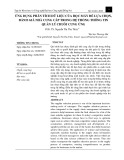



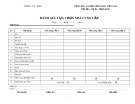
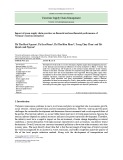
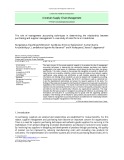
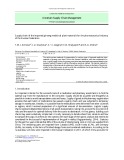
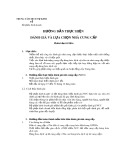








![Đề kiểm tra Quản trị logistics [mới nhất]](https://cdn.tailieu.vn/images/document/thumbnail/2025/20251015/2221002303@sv.ufm.edu.vn/135x160/35151760580355.jpg)
![Bộ câu hỏi thi vấn đáp Quản trị Logistics [năm hiện tại]](https://cdn.tailieu.vn/images/document/thumbnail/2025/20251014/baopn2005@gmail.com/135x160/40361760495274.jpg)






